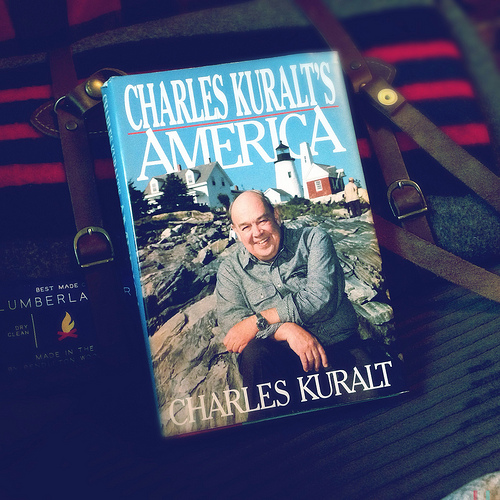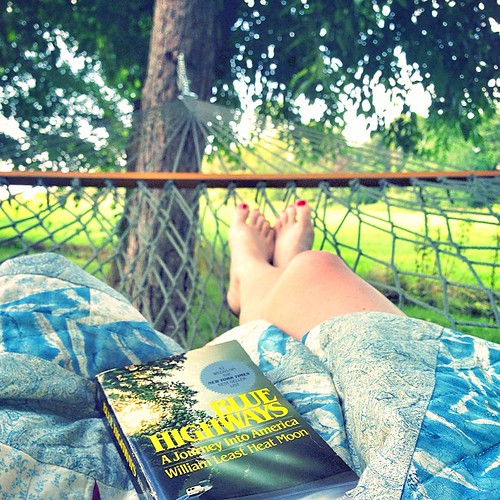Right off the bat I should admit that I didn’t know who Charles Kuralt was when I picked up a copy of Charles Kuralt’s America on the shelves of the Friends Bookstore at Kalamazoo Public Library, while home in Michigan over the Fourth of July. His 37 years on the air with CBS didn’t overlap with the part of my life when I’ve been aware of who is on the news (I don’t watch TV news now either, so I’m still not terribly up to date), and he passed away (too young) in 1997, when my biggest concern was remembering inorganic chemistry equations in 8th grade.
But I’ve been on a travel writing kick, and was hooked after reading the jacket copy. Kuralt set off on a journey throughout the US, to his 12 favorite places that he encountered during his many years of traveling the country for work. He had no set budget, no itinerary. He mapped out his locations based on the perfect time of year to visit each. He set out to have a perfect year in America. Add in the fact that the hardcover copy I found was only $1, and I felt like I had struck book shopping gold. (I also found Blue Highways by William Least-Heat Moon in this same excursion, described later in this post.)
I wanted to get the audiobook version to listen to, which he reads in his booming, friendly voice. But the only edition available on Audible was abridged, a word that makes me shake my head and wrinkle up my nose. Luckily, Charles Kuralt conveys his personable, easygoing manner in his writing as well, and it’s the next best thing to listening to him directly.
In my opinion, the best travel writing does two things:
1. Tells you interesting stories and anecdotes about real people encountered along the journey – either fellow travelers, or the local people of the destination. It’s not all about the traveler, it’s also about the people they meet along the way that shaped the experience.
2. Describes the destination in a way that makes it seem worth seeing for yourself. And also describes it in a way that makes you sort of feel like you have. It both satisfies and encourages wanderlust.
When you read travel writing that was published one or more decades ago, you’re also adding an element of history. You’re reading a snapshot of a moment, a place, and real people. Charles Kuralt’s year in America paints of picture of the changing landscape of America in the 1990s. Many economic and technological factors were changing the ways of life in the places he visited and he records conversations he has with locals that give you a sense of America during this time. I enjoyed that aspect of his account, but most of all I loved the joy he felt for spending meandering days in his favorite American places, and how masterfully he conveys his joy and enthusiasm to the reader so you can experience it with him.
I love this passage in particular, which I relate to completely. I don’t fly fish, but it reminds me of the challenges and pleasures in hiking and camping in America’s great outdoors:
“I never string up a trout rod without wild anticipation. Often, I’ve been exhausted on trout streams, uncomfortable, wet, cold, briar-scarred, sunburned, mosquito-bitten, but never, with a fly rod in my hand, have I been unhappy. I can’t express the joy I felt in my Montana September, driving slowly along a different river day after day, free of all obligations and open to all possibilities, with my fishing bag in the passenger seat beside me.”
As I was reading about Charles Kuralt’s journey around America, I was also listening to the audiobook (and reading along in my old 50 cent paperback copy I also got at the Friends Bookstore) of Blue Highways by William Least Heat Moon. These two men traveled in different decades and had completely different motives and goals for their journeys, but their trips seemed to compliment each other and they wove throughout the US in my mind, sometimes overlapping each other and discovering complementary truths.
William Least Heat Moon’s journey was a much more frugal one, in a converted van (named “Ghost Dancing”) that he could sleep and cook in while traveling across the country on “blue highways” – the back roads of America marked on old maps in blue (the main highways were red). His journey also had a more introspective approach – rather than traveling for a the joy of spending time in the destinations, like Charles Kuralt, he set off on a journey of escape, change, and self discovery on the heels of separating from his wife and losing his job.
“A man who couldn’t make things go right could at least go. He could quit trying to get out of the way of life. Chuck routine. Live the real jeopardy of circumstance. It was a question of dignity.”
I listened to the audiobook while reading along (marking up much of the book with my pen, as there was so much I wanted to note and remember), and it was a great experience. Joe Barrett’s performance is perfectly suited to accompany William Least Heat Moon on the back roads of the US in 1978.
The combination of his meditative reflections, his consultation of Walt Whitman & quoted passages from Leaves of Grass, and the wisdom shared by the people he encounters along the way combine into a Zen-like journey. Like Charles Kuralt’s account, you’re also getting a historical picture of small towns in America in 1978, and the diverse Americans he meets along the way. You gain insight into a lot of challenges of that time (most are still relevant today): race relations in the south, the Native American experience on reservations, the struggles of small business owners.
Charles Kuralt makes you long to travel to the wonderful places he has shared with you, while William Least Heat Moon helps you understand the value and opportunity that the journey itself provides. I will revisit both often.

